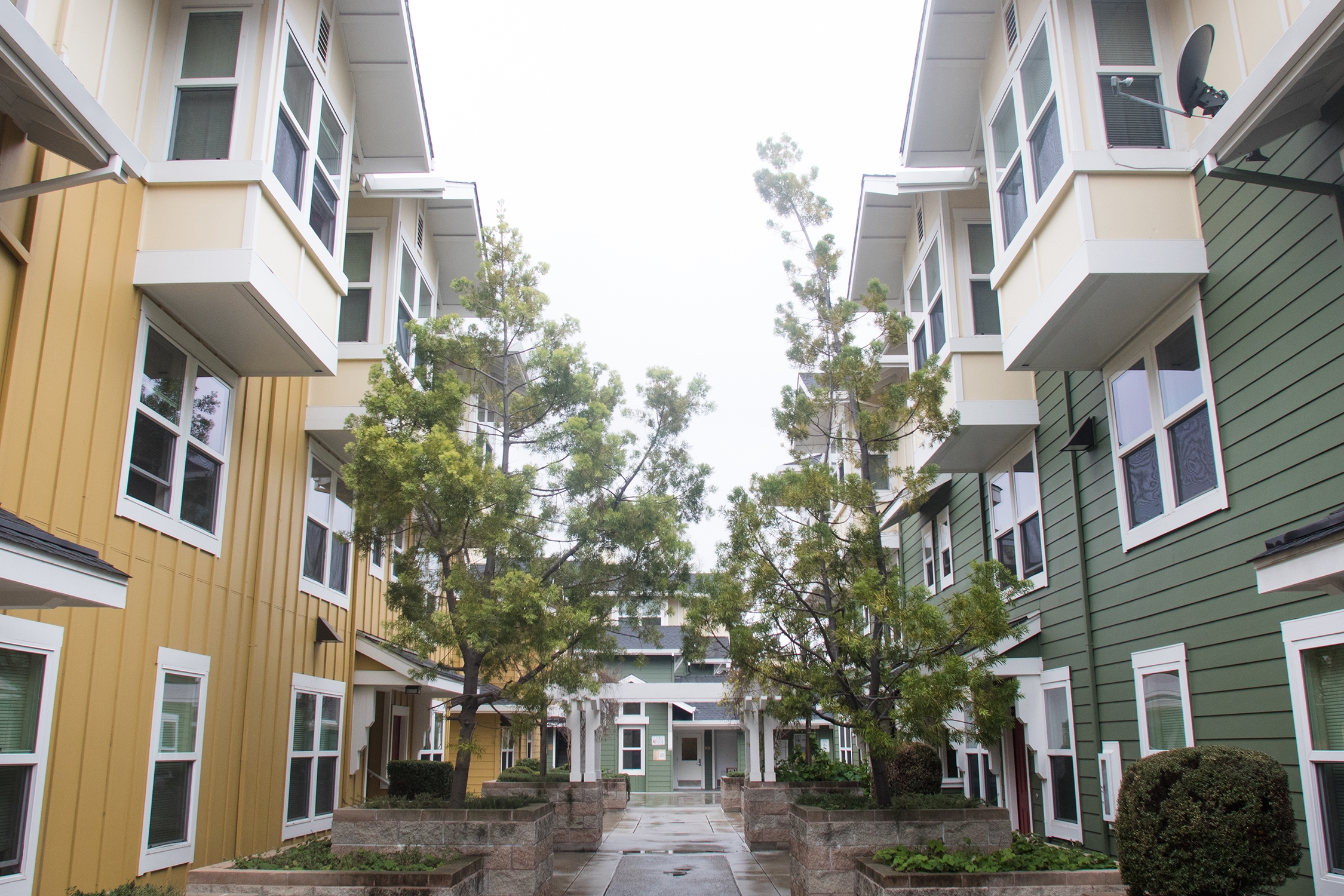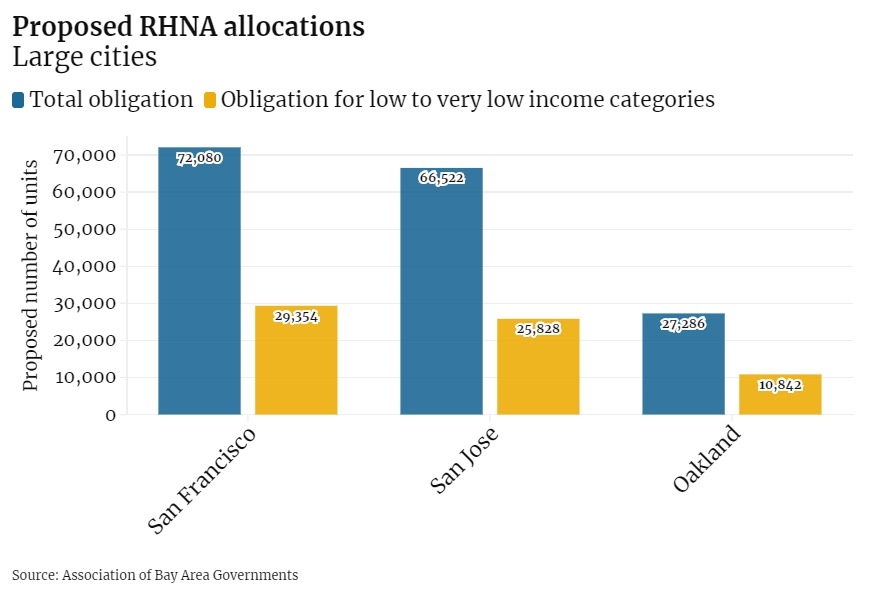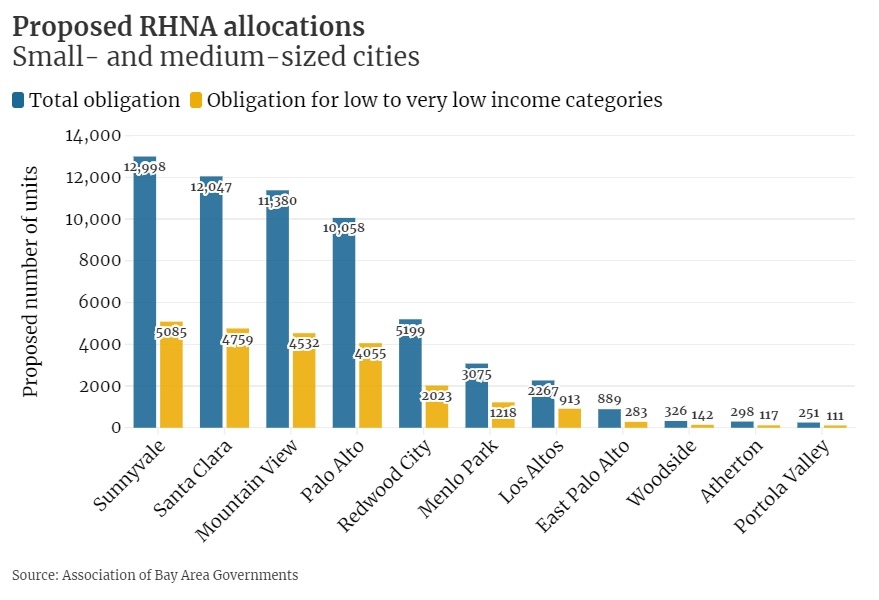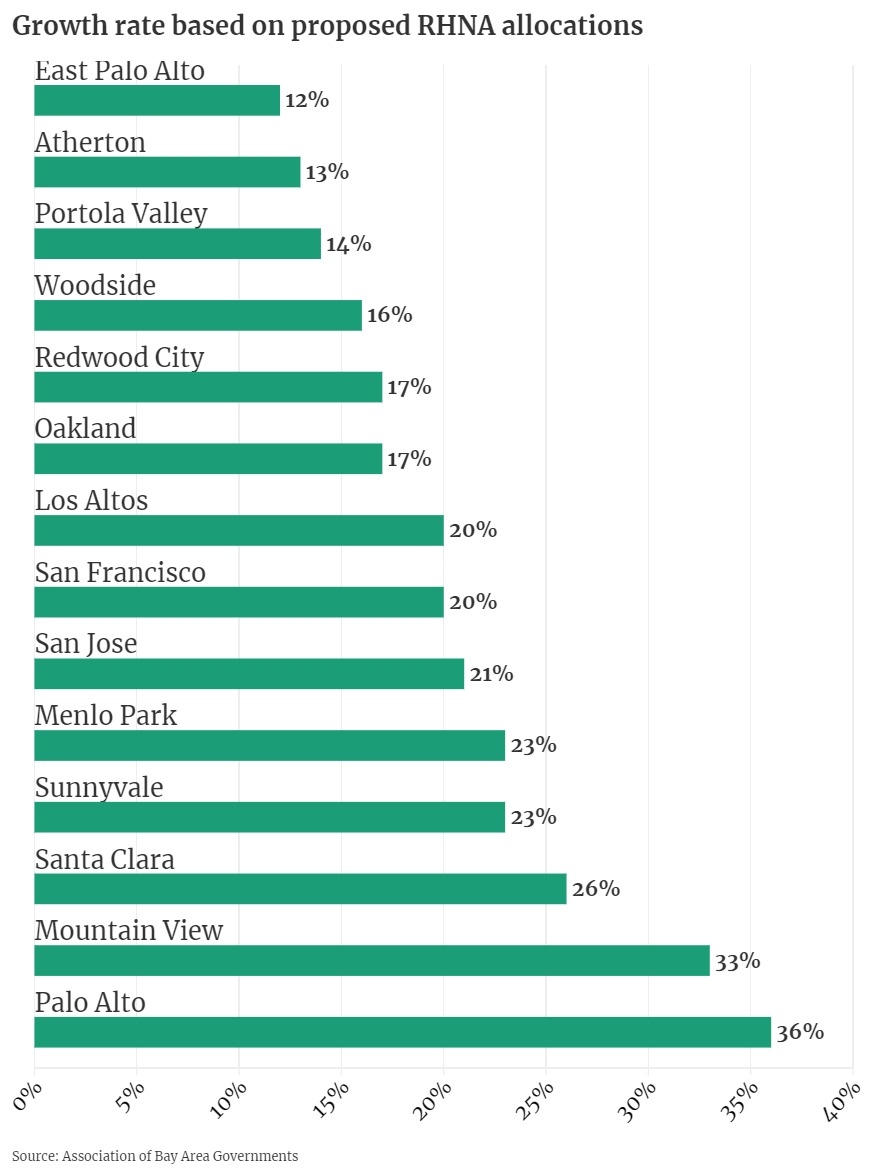Sometime in early 2021, city planners throughout the Bay Area will receive a daunting assignment: a mandate to accommodate their cities' "fair share" of the region's projected housing growth.
Each of the 101 cities and nine counties that make up the Association of Bay Area Governments (ABAG) will receive a portion of the 441,176 housing units that the California Department of Housing and Community Development has assigned to the Bay Area for the next cycle of the Regional Housing Needs Allocation (RHNA), which will run from 2023 to 2031. The state agency had also determined that 114,442 of these units — or 25.9% of the total — should be designated for those in the "very low" income category.
While the numbers for each city and county won't be formally adopted until early next year, the Association of Bay Area Governments offered a preview of what's to come on Oct. 15, when its Executive Board adopted a methodology for doling out the allocations, completing a complex and contentious exercise that began in fall 2019.
The committee, which consists of elected leaders from various ABAG jurisdictions, endorsed by a 24-9 vote the methodology developed by its Housing Methodology Committee. That committee, which is chaired by Berkeley Mayor Jesse Arreguín, concluded its year of deliberations on Sept. 18 by adopting what's known as Alternative 8A. Its decision was subsequently affirmed on Oct. 1 by ABAG's Regional Planning Committee and on Oct. 15 by the Executive Board.
The approved alternative tries to spread the responsibility for new housing throughout the Bay Area, though it does so unevenly. It directs most of the housing toward cities that have plenty of jobs and transportation services and that are deemed "high opportunity" areas based on economic, educational and environmental factors. It also looks to place additional obligations on cities that exhibit economic and racial exclusion. Nearly 60% of the obligation will go to the area's three largest cities — San Francisco, San Jose and Oakland. San Francisco would have to plan for 72,080 housing units, San Jose for 66,522 and Oakland for 27,286.
Silicon Valley would see dramatic growth under the proposed scenario. Jurisdictions in Santa Clara County account for 143,550 of the units between 2023 and 2031, a third of the nine-county region's total allocation. Alameda County is a very distant second, with a 19% share and 85,689 total units.
Alternative 8A creates two different methods for determining how many housing units each jurisdiction should build: one for low-income housing and another for market-rate housing. Allocation for housing units in the "very low" and "low" income categories would be primarily based on the existence of "high opportunity areas" in a given jurisdiction. That factor alone accounts for 70% of the allocation. The remaining 30% is split evenly between two factors: the ability to reach a job by car within 30 minutes and the ability to reach a job by transit within 35 minutes.
For "moderate" and "above moderate" units, 60% of the allocation is based on job proximity by an automobile, while the other 40% is based on access to "high opportunity areas."
The housing numbers are particularly eye-popping in Palo Alto and in Mountain View, two cities that enjoy a wealth of jobs, quality schools, Caltrain access and a broad swath of census tracts listed as "highest opportunity" on the state housing department's "opportunity map." Alternative 8A assigns 10,058 housing units to Palo Alto, which includes 4,055 units in the "very low" and "low" income categories, between 2023 and 2031 — a reach for a city that has consistently failed to meet its own target of 300 new units per year. If the city were to actually build this housing, the new units would represent a growth rate of 36%, higher than any other city in the county.
Mountain View is expecting an assignment of 11,380 units, with 4,532 of them in the two lowest income categories. Its growth rate would be 33%, according to ABAG.
The cities of Santa Clara and Sunnyvale would be asked to plan for 12,047 and 12,998 housing units, respectively, though because they have larger populations the additional housing represents growth rates of 26% and 23%, respectively.
The Oct. 15 decision is not yet final. Residents and cities will have a chance to offer comments to ABAG before final housing allocations are released. Even so, the Executive Board's vote represented a major milestone for a yearlong process that featured dozens of meetings involving housing advocates, builders, county supervisors and council members from ABAG's region. Even after Alternative 8A emerged as the favored consensus of the majority, many members expressed all sorts of concerns about the adopted approach.
Officials from Napa and Sonoma counties warned about the perils of requiring heavy growth in environmentally sensitive areas that may be vulnerable to wildfires. Their counterparts from San Francisco and East Palo Alto advocated for more equity and greater obligations for historically exclusive communities.
Representatives from Contra Costa County warned that methodology that allocates too many units into "high opportunity" areas creates an impossible burden small communities that will not be able to accommodate the growth. A coalition of cities from Contra Costa County proposed an alternative that would shift additional allocations to the south bay, saddling the region with 44% of the Bay Area's total housing allocation, compared to 42% under Alternative 8A.
"Many in the surrounding regions are concerned that they are set up to fail under this option 8A, since none of the allocations will actually result in actual housing creation," Matt Rodriguez, city manager of San Pablo, told the Executive Board at its Oct. 15 meeting.
David Hudson, a council member in San Ramon who sits on the Executive Board, also opposed Alternative 8A, arguing that he believed it does not place a heavy enough housing obligation on the jobs-heavy south bay. The region, he said, is projected to receive about two-thirds of the Bay Area's new jobs and its housing obligations should match that. Requiring any less housing, he said, would merely "continue the pattern we have in the last quarter of a century," with south bay cities producing far more jobs than housing.
Palo Alto leaders worry about Alternative 8A for the exact opposite reason. The regional mandate, they have argued in a series of letters to ABAG, represents an impossible task.
"It is fundamentally not reasonable to accept that some jurisdictions will bear the burden of increasing its housing stock upwards of 25% to 40% over the next eight years," Palo Alto City Manager Ed Shikada wrote to the ABAG Executive Board last month. "Not since the end of World War II have established Bay Area communities seen such unprecedented growth.
"Beyond that, consider the actual feasibility of adding 10,000 new housing units in a small to medium size jurisdiction. Higher property values, less land, less federal and state funding to subsidize housing, and known limitations on existing infrastructure all conspire against the ambitious and unachievable housing goals being contemplated by the Committee."
On the other side of the debate are those who believe that wealthy communities have an obligation to go even further in creating low-income housing. East Palo Alto Vice Mayor Carlos Romero, who serves as vice chair of ABAG's Regional Planning Committee, and Oakland Councilmember Nikki Fortunato Bas, a member of the ABAG's Executive Board, both supported adding an "equity adjustment" to the housing methodology. This adjustment would be applied to 49 jurisdictions that are "exhibiting above average racial and socioeconomic exclusion," a list that includes Menlo Park and Palo Alto.
The adjustment, Romero explained, "essentially ensures that every exclusive city or county receives a fair share of the region's very low and income and low income RHNA." Their alternative, known as 6A, would have created a "floor" for the number of "low income" and "very low income" units these jurisdictions have to accommodate.
"This helps eliminate segregated living patterns and opens communities so that Bay Area residents can choose where to live based on needs and preferences, not their racial and economic background," Romero said at the Oct. 15 meeting.
Romero ultimately voted with a majority of the Regional Planning Committee on Oct. 1 to support Alternative 8A. Greg Scharff, a former Palo Alto mayor who also serves on the committee, voted against the proposed methodology. The regional plan, he said, should factor in recent changes in commuting patterns, including the recent push by the Metropolitan Transportation Commission to shift 60% of employees to telecommuting.
Scharff also suggested that focusing housing allocation on expensive areas will make the housing more difficult to build.
"I do worry we're going to create less housing than if we look at it in other ways," Scharff said. "One of the goals should be to create as much housing as possible."
Despite the conflicting reservations, all three of the committees that reviewed Alternative 8A ultimately voted to approve it. Mountain View Council member Chris Clark, who sits on ABAG's Executive Board, spoke for many when he called it a suitable compromise.
"I believe that with option 8A we have arrived at what is a hallmark of a compromise where no one is 100% satisfied with something but no one is 100% dissatisfied with the outcome," Clark said.
The debate over housing methodology is expected to continue over the next month, as ABAG moves ahead with the comment period on its proposed methodology. After receiving and responding to comments in November, the agency plans to vote on a draft methodology in December. After the appeal period, the agency would formally release each city's allocations in 2021.
"It's fair to say, we're at the beginning of the home stretch," Matt Maloney, director of regional planning at ABAG said at the Oct. 15 meeting.
Regional Housing Needs Allocation, he told the Board, is a "tough process."
"The number we received from the state, 441,000, is much bigger than last time, when it was 187,000. So there is sticker shock and it's also a zero-sum game, so any change that results in a jurisdiction getting less means someone else gets more," he said.
In Palo Alto, city leaders are pursuing a two-pronged strategy: protesting the allocations and planning for their adoption. In a memo last week, Planning Director Jonathan Lait called ABAG's allocation of more than 10,000 units to Palo Alto "unreasonable."
"It is practically infeasible for a jurisdiction the size of Palo Alto to drastically increase the number of housing units in a short period of time," the report states.
While the city is not required to actually build all the housing in the allocation, it is required to update its Housing Element to identify the sites that can accommodate the units, as well as the strategies that the city is pursuing to enable development. This could include rezoning commercial sites to residential use and relaxing development standards to allow more housing units.
Some members of the City Council believe the entire RHNA process is critically flawed and reject the notion that the city could — or should — try to meet the regionally adopted targets. In July, shortly after the state housing department determined that the Bay Area region needs to plan for 441,000 new units, Vice Mayor Tom DuBois and council members Eric Filseth and Lydia Kou co-authored a letter to Shikada, City Attorney Molly Stump and Lait expressing their objections to the agency's growth figures.
The numbers, they argued in the July 9 letter, are based on "an aggressive and unrealistic job growth projection for the Bay Area and Silicon Valley in particular — even before COVID-19."
"These jobs growth numbers have been translated into unachievable housing growth rates, especially affordable housing growth rates, that simply cannot be met under any zoning without massive outside investments — subsidies which have never been forthcoming in the past, and are unlikely to appear in the future," the letter states. "The HCD plan represents a gigantic unfunded mandate."
At the same time, council members and planners recognize that the RHNA, which was once relatively easy to ignore, is starting to grow some teeth. Under Senate Bill 35, cities that fall well short of their targets in particular income categories will lose some of their power to say no to new developments in these categories. The 2017 law creates a streamlined approval process in these communities, requiring approval of housing developments within either 60 days or 90 days, depending on the number of units. In addition, these developments would be allowed to dedicate 10% of their units to below-market-rate housing, below the city's normal standard of 15%.
During an Oct. 5 discussion of the city's newly created "planned housing zone," Lait told the council that the city has an interest in meeting the SB 35 thresholds to "maintain local control." Otherwise, housing developments would be approved by right, with no design review and, in some instances, with substantial breaks on parking, Lait said.
Others welcome the RHNA process as an opportunity to implement some much-needed changes. During the council's Sept. 21 discussion of affordable housing, Mayor Adrian Fine observed that while some dismiss the city's allocation of more than 10,000 units as "crazy," the process also creates an opportunity for the city to "exercise local control."
"I think it's good for our community to create new neighborhoods and places for new families," Fine said. "It's also good in terms of our diversity and, frankly, it begins to fulfill a small part of the regional obligations, which I know some of us have issues with, but that hammer isn't getting any softer."






Comments
Registered user
Jackson Park
on Oct 22, 2020 at 3:11 pm
Registered user
on Oct 22, 2020 at 3:11 pm
It's a very bad business move to build and invest in a new property only to have some arbitrary number of units marked as below market value (aka. affordable to the very low income levels). It's no wonder that developers are hesitant to build in MV. How about instead we let the developers and the market decide on how many and what types of units are developed? People will select the housing that they can afford, be it new or an older development. No special rules or regulations necessary. Look up "planned economy" in Google and try to find an example of a success.
Registered user
Old Mountain View
on Oct 22, 2020 at 3:56 pm
Registered user
on Oct 22, 2020 at 3:56 pm
In response to Waylonis you wrote:
“It's a very bad business move to build and invest in a new property only to have some arbitrary number of units marked as below market value (aka. affordable to the very low income levels).”
However it is also very bad planning to NOT build proportional housing grades in the region. And in fact the ABAG RHNA and the state land laws as they become more strict will eventually force good business plans. In fact this is related to what you wrote here:
“It's no wonder that developers are hesitant to build in MV.”
The STATE laws are applicable EVERYWHERE. Mountain View is not any different to any other city. So your point to single out Mountain View makes no sense at all. You went on to write:
“How about instead we let the developers and the market decide on how many and what types of units are developed?”
When they do not build proportionally, they set the area up for a major downfall. Again lets look at the current rents in Mountain View from Zumper here (Web Link The year over year rent for a studio apartment is -12% and is lower than it was in 2014. A One Bedroom apartment is down 36% year over year and is below the same rate in 2015. The 2 bedroom apartment is down year over year 29% and is at the same rate as 2015. A 3 Bedroom apartment year over year is down 16% and below the rate it was in 2015.
The reality is that many projects are being put on hold or even canceled because COVID and AB5 still hasn’t finished with the valley yet. You wrote:
“People will select the housing that they can afford, be it new or an older development. No special rules or regulations necessary. Look up "planned economy" in Google and try to find an example of a success.”
The concept of INCLUSIONARY housing is not based on a “planned economy” but is a plan to prevent disparate impact housing discrimination. Which appears to be what you are in favor of. Remember you don’t need to intend to be discriminating against anyone, but in your business practices you in fact do discriminate, you are just as guilty.
Registered user
Waverly Park
on Oct 22, 2020 at 10:05 pm
Registered user
on Oct 22, 2020 at 10:05 pm
Does this goal come with a grant for say $800,000 per apartment unit x 13,000 units = ~$10B? At $3M per house in Waverly Park you could build and sell 3,333 market rate single family homes but where to put them? Where to educate the kids that will live in them? The neighborhood went ballistic over a plan to put a dozen on school district property next to Cooper Park and that's just 1/10th or 1% of the goal. Isn't it time to admit that people don't want more housing around them (note Sally Lieber's massive fail in the Assembly election as the only candidate favoring 4-plexes in single family zoned areas). I think we have to bite the bullet and say Mountain View is closed to new office buildings, we can't house workers we have and can't educate the kids of the people we've got. Tell Google to keep the workers remote and build somewhere else.
Registered user
Cuesta Park
on Oct 23, 2020 at 11:21 am
Registered user
on Oct 23, 2020 at 11:21 am
Uh - Didn't Lieber come in third? The souvergenty of the State of California allows the state to let cities exist and allows them to pass zoning laws. THESE LAWS ARE RESTRICTIONS ON PRIVATELY OWNED LAND. You cannot build a gasoline storage/distribution site in the middle of a residential area. (like the one near BMW and the Stevens Creek Trail/bridge). Or a market. In Texas/Houston it's a Wild West open season on whatever-the-owerner-wants!
I support the State exercising it's power through this sub-agency. Those who understand task forces/commissions etc. might recognize a study/majority consensus model (not unanimity). Like the Commission on Redistricting independent commission for political seat boundaries.
A good commission, a sound process of choosing among staff presented alternatives (Options) and a reasonable HOUSE THOSE WORKERS YOU Allowed "boot to the backside" from the state to cities! Close down new job-site creation or else. And this is the "else" from past actions. Jobs-Housing Imbalance.
Thanks TBM, this is pretty simple economics meshed with state-wide mandates.